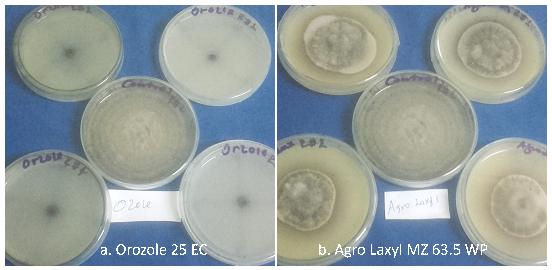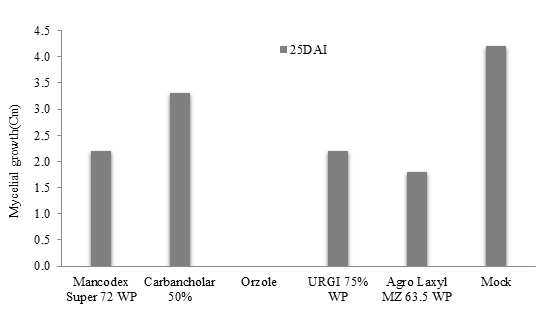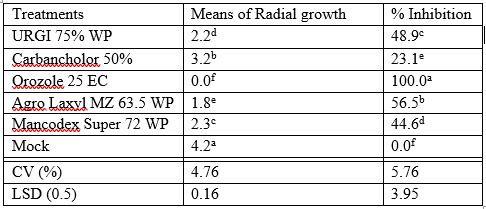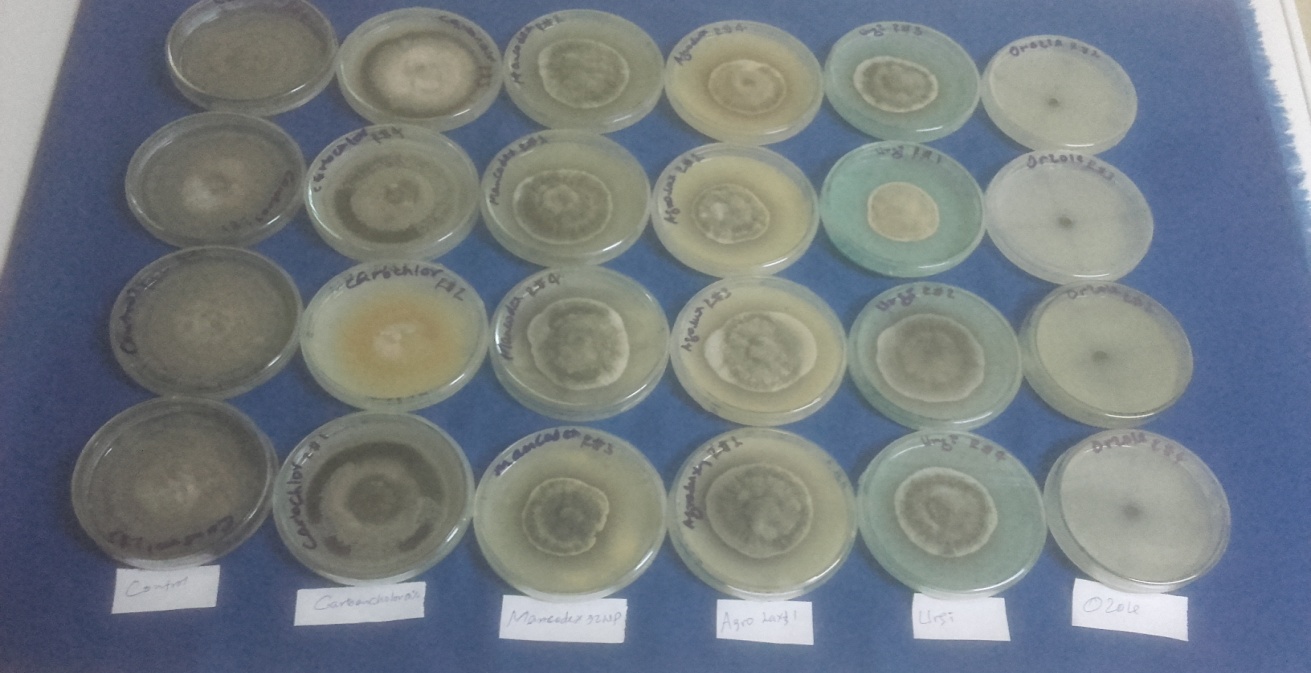Agricultural Research Pesticides and Biofertilizers
OPEN ACCESS | Volume 2 - Issue 1 - 2025
ISSN No: 2994-0109 | Journal DOI: 10.61148/2994-0109/ARPB
Endriyas Gabrekiristos* and Getachew Ayana
Ethiopian Institute of Agricultural Research, Melkassa Agricultural Research Center P.O. BOX 436, Adama, Ethiopia.
*Corresponding Author: Endriyas Gabrekiristos, Ethiopian Institute of Agricultural Research, Melkassa Agricultural Research Center P.O. BOX 436, Adama, Ethiopia.
Received: July 08, 2021
Accepted: July 10, 2021
Published: July 20, 2021
Citation: Endriyas Gabrekiristos and Getachew Ayana. (2021) “In Vitro Evaluation of Some Selected Fungicides against Early blight of tomato (Alternaria solani) in Ethiopia.”, Journal of Agricultural Research Pesticides and Biofertilizers, 2(2); DOI:http;//doi.org/07.2021/1.1032.
Copyright: © 2021 Endriyas Gabrekiristos. This is an open access article distributed under the Creative Commons Attribution License, which permits unrestricted use, distribution, and reproduction in any medium, provided the original work is properly cited.
Tomato is one of the most popular vegetable crops grown throughout the world in general and in Ethiopia in particular. Production of the crop is constrained by different diseases where disease caused by early blight pathogen is among the major ones. Early blight has been considered as commonly occurring and causing significant economic impact on yield and quality of the crops. Major tomato diseases in general and early blight in particular could be best managed by integrating a number of control practices and application of fungicides. Application of fungicides is the most convenient and predominant way for disease control in absence of resistance varieties. The present study was conducted to evaluate the efficacy of some selected fungicides with the objectives of (1). Assessing in vitro efficacy of fungicides on growth of pathogens, (2). Assess in vitro sensitivity of pathogens to selected fungicides and (3). Assess in vitro tolerance of pathogens to fungicides and eventually, to find an alternate use of these fungicides as potential foliar spray against Alternaria solani pathogen. Alternaria solani was isolated from tomato showing typical early blight disease. Five different fungi toxicants, i.e., Mancodex Super 72 WP, Carbancholar 50%, Orozole 25 EC, URGI 75% WP and Agro Laxyl MZ 63.5 WP, were investigated at rate or concentration of 3.0x 103gm/ml, 3.3 x 103ml/ml, 3.25 x 102ml/ml, 3.0 x 103gm/ml and 3.0 x 103gm/ml respectively. A dual culture technique has been used to evaluate the efficacy of each fungicide. The study revealed that the highest reduction percentage of A. solani growth was recorded with Orozole 25 EC followed by Agro Laxyl MZ 63.5 WP resulting 100% and 56.5% mycelial growth inhibition respectively. However, Carbancholor 50% was less performing treatment recorded in reduction of mycelial growth of A. Solani. Fungicide showed better efficacy in invitro condition could be further tested for stable efficacies under field condition and verified for economic validity. The study indicated potential fungicides for the management early blight on tomato.
Introduction:
Tomato (Solanum lycopersicum L.) is one of the most important vegetable crops grown around the world and is second crop in production next to potato (Mutschler et al., 2006). The crop is mainly produced by small scale farmers and commercial growers for its fruits in different regions of Ethiopia. It is produced both during the rainy and dry seasons under supplemental irrigation (Lemma, 2002). Nutritionally, tomato is rich source of Vitamin A, C, E and good source of antioxidant and contains 95.3% of water, 0.07% calcium and niacin, which play importance role in metabolic activities and maintain good human health (Sgherri et al., 2008). The average yield of tomato in Ethiopia is low, ranging from 6.5-24 Mt/ ha (Gemechis et al., 2012). Under this circumstance the total area under tomato production in Ethiopia reaches 9767.78 ha and in Meher season production is estimated to be over 913,013.42 ton with the average productivity of 93.47 t per hectare (CSA, 2016).This is incomparable with the average yield of other countries such as China, USA, Turkey, India, Egypt, Italy and Spain with average yield of 22.67, 80.61, 35.81, 18.61, 40.00 and 76.35 ton/ha in that orders (FAOSTAT, 2010).
The average low yield of tomato in Ethiopia could be attributed to different production constrains where diseases caused by different pathogens are the major ones. Tomato crop is vulnerable to different fungal, bacterial and viral diseases (Sakhuja et al., 2004). In Ethiopia, early blight (Alternaria solani), late blight (Phytophthora infestans), fruit spot (Xanthomonas campestris pv. vesicatoria), Septoria leaf spot (Septoria lycopersici), powdery mildew (Leveillula taurica), bacterial wilt (Ralstonia solanacearum), tomato leaf curl (Tobacco virus or Nicotiana virus 10) and plant-parasitic nematodes are the major and economically important tomato diseases of all tomato growing areas (Sakhuja et al., 2004; Tesfaye and Habtu, 1985). Early blight caused by Alternaria solani has been considered as most commonly occurring and causing significant economic impact on yield and quality of the crops. Major tomato diseases in general and early blight in particular could be best managed by integrating a number of control practices that may include: selection of disease-tolerant or disease-resistant varieties, different cultural practices (crop rotation, time of planting, level of fertilization, micro-climate modification, sanitation etc), and application of fungicides. Among the fungal diseases, early blight of tomato caused by Alternaria solani is the most damaging one that causes reduction in quantity and quality of the tomato (Majeed et al., 2014). Alternaria solani is air-borne pathogen responsible for leaf blight, collar and fruit rot of tomato spread by fungal spores (Abada et al., 2008). Major tomato diseases in general and early blight in particular could be best managed by integrating a number of control practices that may include: selection of disease-tolerant or disease-resistant varieties, different cultural practices (crop rotation, time of planting, level of fertilization, micro-climate modification, sanitation etc), and application of fungicides. Application of fungicides is the most convenient and predominant way for disease control in absence of resistance varieties. The use of fungicides could be considered as an alternative method to reduce the yield reduction due to different fungal diseases. Application of fungicide requires determination and identification of their efficacies. However, the efficacy of fungicides is influenced by many biological and environmental factors that directly influence the metabolic activities of fungal cells (Reinprecht 2010). Efficacy of fungicides could be studied under field and invitro conditions. In-vitro methods for fungicide efficacy testing are a group of analytical methods which reproduce a range of environmental factors under artificial, laboratory, conditions. In-vitro efficacy tests help for reduction of the factors that influence the results of treatments at the experimental stage, shortest period to obtain primary data and enable to test multiple fungicides and targets simultaneously. Therefore, evaluating the inhibitory activity of some selected fungicides on the growth of A. solani the causal agent of tomato early blight is considered as first test step screen potential fungicides as alternative management options. The objectives of the current study were to (1). Assess in vitro efficacy of fungicides on growth of pathogens, (2). Assess in vitro sensitivity of pathogens to various fungicides and (3). Assess in vitro tolerance of pathogens to fungicides and eventually, to find an alternate use of these fungicides as potential foliar spray against Alternaria solani pathogen.
2. Material and Methods:
An invitro efficacy test was conducted at Melkassa Agricultural Research Center in Plant Pathology Laboratory during September to November 2020 using five fungicides.
2.1. Isolation and identification of Alternaria solani:
The infected plant, showing characteristic symptoms of early blight disease was cut with healthy portion into 2mm, surface sterilized with 0.1 percent sodium hypochlorite solution, thrice rinsed with sterilized distilled water and then transferred aseptically on PDA medium in Petri plates having 9cm diameter. These Petri plates having half infected and half healthy cut piece of sample were incubated at 27°C, which is favorable temperature for the pathogen. After 3 days, a whitish growth of mycelium was observed and a portion from the periphery having single hyphal tip was separated and transferred to other Petri plates having medium to get pure culture and identification of the pathogen was confirmed by observing the morphological features of mycelium and spore formation by Camera mounted compound microscope. The pathogen Alternaria has septate, dark coloured mycelium and produce short, simple, erect conidiophores that bear single and branched chains of conidia in acropetal chains (figure 1).

Figure 1: Blight symptom on fruit and leaf of tomato caused by alternaria solani; picture taken by endriyas g., 2020
2.2. Fungicides used and In vitro Evaluation method:
A total of five fungicides were evaluated under in vitro conditions against A. solani through food poisoned technique using Potato dextrose agar medium (Gabrekiristos E, Ayana G., 2020). Accordingly, the in vitro antagonistic potentials of five fungicides (URGI 75% WP, Carbancholor 50%, Orozole 25 EC, Agro Laxyl MZ 63.5 WP and Mancodex Super 72 WP) were evaluated according to (Irfan and Khalid, 2007). The selected fungicides were evaluated via dual culture assay according to Irfan and Khalid (2007). The replication of treatments was done four times and untreated suitable control was maintained. In vitro evaluation of fungicides at different rate was based on the amount of water used to dilute the medium and fungicide rate determination was also done based on the water in the medium (Gabrekiristos E, Ayana G., 2020). The radial growth of the fungal mycelium was recorded on 3rd, 11th, 18th and 25thday’s intervals.
No Trade Name Common name Rate
1 Mancodex Super 72 WP Metalaxyl + Mancozeb 3.0x 103gm/ml
2 Carbancholar 50% Carbendazim + Chlorothalonil 3.3 x 103ml/ml
3 Orozole 25 EC Propiconazole 25% EC 3.25 x 102ml/ml
4 URGI 75% WP Carbendazim + Mancozeb 3.0 x 103gm/ml
5 Agro Laxyl MZ 63.5 WP Mancozeb + Metalaxyl 3.0 x 103gm/ml
6 Mock Control water

Table 1: List of evaluated fungicides and their descriptions
2.3. Test procedures:
The inhibitory effect of fungicides on the growth of A. solani isolate was evaluated using the dual culture technique. Tested chemicals were added to conical flasks containing sterilized PDA medium before its solidifying to obtain the proposed concentrations and rotated gently to ensure equal distribution of added fungicides within the medium (Gabrekiristos E, Ayana G., 2020). A separate PDA flask free of tested fungicides was used as mock (control) treatment. The supplemented media were poured into sterilized petri-dishes (9cm) approximately 15 ml per each. Mycelial disc (6mm) taken from the periphery of an actively growing PDA culture of tested fungus A. solani was placed at the centre of the prepared petri dishes, then incubated for twenty-five days at 27℃. The average linear growth diameter of colonies was measured and reduction in fungal growth was calculated in relative to mock treatment. The mycelial growth inhibition by fungicides were observed and recorded at 3rd, 11th, 18th and 25th day’s intervals. The inhibition of A. solani mycelial growth was calculated by; I=(C-T)/C×100, Where, I, C and T refers to I = percent inhibition of mycelial growth, C = radial growth of fungus in control, T = radial growth of fungus in treatment.
2.4. Statistical Analysis:
The experiment was set up in a complete randomized design (CRD) having four replication and each treatment were repeated two times. One-way ANOVA was used to analyse differences between antagonistic inhibitor effect and linear growth of pathogenic fungi in vitro. A general linear model option of the analysis system SAS 9.3 was used to perform the ANOVA. Duncan’s multiple range tests at P ≤ 0.05 level was used for means separation (Winer, 1971).
3. Results and Discussion:
In vitro efficacy of selected Fungicides against Alternaria solani:
Five fungicides were evaluated in vitro, for knowing their efficacy against the pathogen, A. solani causing early blight of tomato through poisoned food technique. In the present study, all tested fungicides showed antifungal activity against early blight pathogen (A. solani) by reducing the mycelial growth. Orozole 25 EC, Agro Laxyl MZ 63.5 WP, Mancodex Super 72 WP, Carbancholor 50% and URGI 75% WP inhibited radial growth, sporulation and germination of Alternaria solani.
The results showed that all tested fungicides significantly (P≤ 0.05) inhibit the mycelial growth of the pathogen with different magnitude compared with control (Table 2).Orozole 25 EC and Agro Laxyl MZ 63.5 WP are among five fungicides having the nature of both systemic and contact action inhibited the growth of the test fungus (Table 2 and figure 2) having a good a toxic ingredient on test pathogen. The fungicidal nature of selected fungicides on A. solani were started the inhibitory activities from the first date of incubation. From evaluated fungicides fungicidal and fungistatic nature were evaluated and the use of protectant or eradicate fungicides to control fungal diseases depends on their ability to inhibit germination, growth and sporulation (Mehrotra and Aggarwal, 2003).

Figure 2: Growth of A. solani isolate on PDA amended with a. Orozole 25 EC and b. Agro Laxyl MZ 63.5 WP
Data regarding mycelial growth revealed that Orozole 25 EC was the most effective fungicide on reducing the average linear mycelial growth of A. solani(no growth ) followed by Agro Laxyl MZ 63.5 WP (18.0 mm) after 25 days of incubation period(Figure 2 and Table 2). Similarly, Benlate achieve limited inhibition of growth, sporulation and germination of A. solani, it has been reported to be a highly effective and broad-spectrum systemic fungicide against Fusarium solani, and Rhizoctonia solani (Nawar, 2007). Of all tested fungicides, complete inhibition was observed on the plate treated by Orozole 25 EC (Propiconazole 25% EC) as a result the fungicide exhibited the highest toxicity to A. solani (figure 2a).The observed differences in the performance of tested fungicides could be due to detoxification before the site of action has been reached, lack of conversion of a compound into the fungi-toxic principal or the production of inhibitory factor (Cremlyn, 1991).

Figure 3: Mycelial growth of A. solani after 25 days post incubation on potato dextrose agar
Orozole 25 EC was highly effective in reducing the radial mycelial growth of A. solani. Similarly, in the experiment conducted on effect of some fungicides against early blight of tomato, the maximum disease management was obtained in the treatment carbendazim 12 % + mancozeb 63 % WP @ 0.2 % concentration followed by propiconazole 25 EC @ 0.025 % concentration (Sharma et al., 2018).

Table 2: Effect of fungicides on mycelial growth of early blight after twenty-five days
Means followed by same letter indicate no significant difference between treatments LSD test (P ≤ 0.05; p= 0.05).

Figure 4: Mycelial growth of Alternaria solani of tomato treated by different fungicide
Orozole 25 EC (Propiconazole 25% EC) performs top among evaluated fungicide by complete inhibition of A. solani without showing any mycelial growth staring from culture date. The mycelia inhibition recoded was 100, 56.5 and 48.9% on Orozole 25 EC, Agro Laxyl MZ 63.5 WP, Urgi 75% WP, respectively. However, the minimum inhibition in mycelial growth was recorded in Mancodex Super 72 WP and Carbancholor, 44.6, 23.1 percent respectively that was significantly lower than rest of the treatments (Table 2; Figure 4, 5). Interestingly, Orozole 25 EC (Propiconazole 25% EC) is best performing fungicide in this study. In a study by Chavan (2007) reported complete inhibition of the F. solani mycelial growth in vitro with carbendazim and carbendazim 12%+mancozeb 63%. Nikam et al. (2007) reported carbendazim alone and in combination with thiram was most effective against growth inhibition of Fusarium oxysporum.

Figure 5: Mycelial growth inhibition of A. Solani of tomato on PDA medium in vitro condition; (A) untreated Check. (B) Carbancholor 50%. (C) Mancodex Super 72 WP. (D) Agro Laxyl MZ 63.5 WP. (E) Urgi 75% WP and (F) Orozole 25 EC.
Summary and Conclusion:
Among various diseases of tomato caused by fungi, Late blight and early blight caused by Phytophtora infestans and Alternaria solani is priority in Ethiopia. Now a day bacterial leaf spot is also emerging in Ethiopia mainly in the central Rift valley. This pathogen is identified in most of tomato producing areas in Oromiya, South Nation Nationalities and peoples and Amhara regions.
New approach was developed in Ethiopian Institute of Agricultural research in Melkassa Research Center by Plant Protection Department. For immediate remediation, evaluating fungicides in vitro and availing for the users is the option to easily reduce the epidemics of the pathogen. In this experiment among the five fungicides in vitro evaluated, three of the fungicides namely (Orozole 25 EC, Agro Laxyl MZ 63.5 WP, Urgi 75% WP), were effective in vitro mycelial growth inhibition. Two of the tested fungicides namely Mancodex Super 72 WP and Carbancholor were found not effective in reducing radial growth and consequently could not serve in controlling the test organism. The mycelia inhibition recoded was 100, 56.5 and 48.9% on Orozole 25 EC, Agro Laxyl MZ 63.5 WP, Urgi 75% WP, respectively.
Therefore, among the tested fungicides which showed high invitro efficacy can be used to manage tomato early blight, specifically Orozole 25 EC and Agro Laxyl MZ 63.5 WP can be recommended for further field evaluation and application. At the same time the economic validity, these fungicides should also be further verified under field conditions.